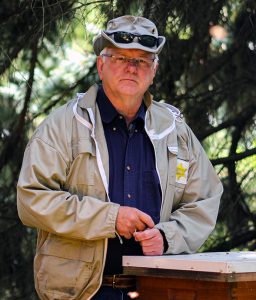by Ed Colby
This feels like the home stretch. The other day when I told my Aspen Mountain ski patrol boss this would be my last season, Bud looked stunned. “Why?” was all he could say.
But to answer Bud’s question, why not? I’m 68. I’ve been doing this for 40 years. I lived the dream. I’ve seen it all. Now I’m weary of getting up at 4 a.m. and sleeping on the bus. My knee aches. And it’s not like we have an armchair in front of the fireplace for the old guys. They boss us around like Marine Corps recruits. So what if this is the best job on Earth? I want to leave before they start whispering about me. I have an exit strategy. I have a lifetime ski pass. The farm’s about paid off. I trade honey and lamb with the chiropractor who doesn’t take Medicare. My bees bring in a little, and I have a renter. Maybe I’ll file for Social Security.
Money seems so important, until you meet someone with stage four cancer, or your neighbor drops dead in the driveway. Rich or poor, we play the hand Fate deals us. Only one certainty: our visit here is short. We’re just passing through.
As the climate talks in Paris drag on, December weather here in western Colorado remains unseasonably warm. I ran into Mary Ann down at Maud’s restaurant. She came home for a family emergency. She has a house way down south in the wild windswept glacier region of southern Chile. Her thermometer read 97 before she flew to Colorado. No one remembers it ever having been so hot in December. She showed me photos of native Chilean bees. She wonders about the orange bumblebees that live in her attic.
Fifty-nine of my 94 colonies got trucked to California in November. They’ll spend the winter in a holding yard. They all had at least ten frames of bees when they shipped. But even in balmy California, Winter takes its toll. About the time you read this, Derrick will give them a last look. Dead-outs get set aside. Weak colonies might get combined to make the grade. Then the little darlings go into the budding, soon-to-blossom almonds, for the greatest honey bee show on Earth. I cross my fingers. Already I’m formulating a Varroa mite knockdown strategy for these bees when they get home. If bees spill out of the boxes, if they haven’t swarmed or starved, if I can split some and make increase, if the truck doesn’t roll on the way back, this is all I can ask for.
Here in Colorado, a load of bees tipped over on Loveland Pass this fall. A guy I work with knows a paramedic who arrived on scene. Hives sat on the roadside and on the road, many of them pretty much intact, until a snowplow pushed them into rubble off the road. My friend showed me photos. “Why didn’t they bring in some beekeepers?” he mused.
Last year the almond pollination price was $180 per hive. That’s $180 gross. It costs to truck bees, to pay Derrick to check on them, sometimes feed them through the California Winter. Lyle gets a cut to fill the contracts and keep an eye on the crop dusters. If all goes well, I get a check, and my bees return home healthy. Last year three colonies vanished. Not even the woodenware came back. We never solved that mystery.
I don’t even know where they are out there. I couldn’t give you the name of the closest town. In the almonds. That’s all I know.
My hives with fewer than 10 frames of bees in November stayed here. So the weakest get to try their luck at surviving our always unpredictable Colorado winter, while the strongest bask in the California sunshine. I took advantage of pleasant December weather to dribble these now brood-less stay-at-homes with oxalic acid, for mite control. Typically, as soon as the queens stop laying in the Fall or early Winter, the temperature drops way below freezing, and I have to wait for a January thaw to dribble oxalic acid. This year I caught a break.
My recipe is 3.67 ounces of oxalic acid (wood bleach) dissolved into two quarts of distilled water. Then I add a four-pound bag of sugar to the mix. I use a garden sprayer to squirt this sweet acidic solution into brood-less hives, three to five ml. per seam of bees, 50 ml. per colony max. It knocks Varroa mites into the next county. When I say “seam of bees” I mean the gap between two deep frames, filled with bees, top to bottom. The little darlings don’t always fill seams top to bottom and from one end to the other, so obviously you sometimes have to estimate. For how-to details, I heartily recommend Randy Oliver’s always informative Scientificbeekeeping.com. And keep this stuff out of your eyes!
This recipe makes three quarts. I treated 35 relatively weak, brood-less, Winter-clustered colonies, using less than a quart of mix. Cost for the whole batch: under five bucks.
Tomorrow the alarm goes off at 4. It’s OK. It’s raining, sure to turn to snow by morning. Tonight my gal Marilyn will pack me a lunch, before she sleeps in my arms. I’m 68 and still living the dream, but this is the home stretch.








